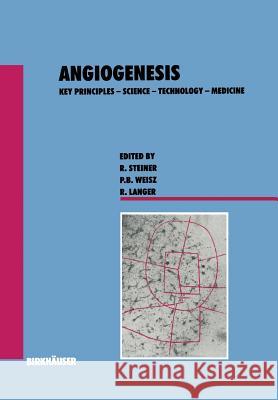Angiogenesis: Key Principles -- Science -- Technology -- Medicine » książka



Angiogenesis: Key Principles -- Science -- Technology -- Medicine
ISBN-13: 9783034870030 / Angielski / Miękka / 2012 / 497 str.
Introductories.- Angiogenesis — Historical perspective.- Angiogenesis — Retrospect and outlook.- Angiogenesis — The interdisciplinary challenge.- Angiogenesis — Cytokines as part of a network.- Angiogenesis — Biomedical technology.- Angiogenesis — Time to review progress.- Angiogenesis — A new fascinating enigma for surgeons?!.- Morphology.- Intussusceptive microvascular growth, a new mechanism of capillary network formation.- Combined morphological approaches in the study of network formation in tumor angiogenesis.- Maturation of newly-formed subretinal vessels.- Embryonic development of the CNS microvasculature in the mouse: new insights into the structural mechanisms of early angiogenesis.- Vascular supply in embryonic neural transplants.- Microvascular network architecture in a mammary carcinoma.- Tumor angiogenesis: evidence of new blood vessel channels from plasma infiltrations.- Molecular Biology.- Receptors for platelet-derived growth factor on microvascular endothelial cells.- Five FGF receptors with distinct expression patterns.- Activation of the tyrosine kinase receptor is not sufficient for the full biological activity of bFGF.- Chemical Engineering.- Angiogenesis and heparin mimics.- Endothelial cell migration and chemotaxis in angiogenesis.- Cell Biology and Dynamics.- Microenvironment and angiogenic response.- Modulation of angiogenesis in vitro.- Proteolytic balance and capillary morphogenesis in vitro.- Metalloproteinase inhibition as a mechanism for the inhibition of angiogenesis.- TPA-induced differentiation of rat aortic endothelial cells is substrate-specific and receptor mediated.- Aortic endothelial cells in culture: factors which modulate their morphological and biosynthetic phenotypes.- The behaviour of pericytes in vitro: relevance to angiogenesis and differentiation.- Identification of non heparin-binding endothelial cell growth factor from rat myofibroblasts.- Differential expression of integrin cell-substratum adhesion receptors on endothelium.- Modulation of extracellular matrix receptors (integrins) on human endothelial cells by cytokines.- Possible mechanisms of type I collagen-induced vascular tube formation.- Basic fibroblast growth factor bound to cell substrate promotes cell adhesion, proliferation, and protease production in cultured endothelial cells.- Thrombospondin modulates basic fibroblast growth factor activities on endothelial cells.- Binding sites for basic fibroblast growth factor on solid tumors are associated with the vasculature.- Studies on basic fibroblast growth factor (FGF-?) gene expression in the rat and pig ovary using in situ hybridisation and quantitative reverse transcriptase-polymerase chain reaction techniques.- Effects of platelet-activating factor on endothelial cells and fibroblasts in vitro.- Angiogenin and endothelial cells.- Cultured endothelial cell mobilization induced by partially purified human uterine angiogenic factor.- Two cloned cerebral endothelial cell phenotypes: an in vitro model for angiogenesis?.- Bone endothelial cells: A tool for analyzing cell to cell interactions in the skeletal tissue.- Expression of angiogenic growth factors in the collateralized swine myocardium.- Tumor cell spheroids induce a mitogenic response in endothelial cells.- A Monoclonal antibody (E-9) binds preferentially to the vasculatures of human tumours, embryonic and regenerating tissues.- Liver or lung colonization by F9 teratocarcinoma cells follows specific interactions with the target organ.- Induction and altered distribution of tenascin in the basal lamina of colorectal adenomas and carcinomas.- Assays and Models.- On the quantitative rat mesenteric-window angiogenesis assay.- Wound healing in aged animals — effects of locally applied transforming growth factor beta in different model systems.- Intradermal angiogenesis in nude mice induced by human tumor cells or b-FGF.- Angiogenic activity of PAF and inhibition of blood flow by Bothrops Jararaca venom in a mouse sponge model.- Furher studies on angiogenesis in a rat sponge model.- A multichannel wounding device for the study of vascular repair in vitro.- Assessment of angiogenic potential — the use of AIDS-KS cell supernatants as an in vitro model.- Biomedical Technology.- Delivery systems for angiogenesis stimulators and inhibitors.- Angiopolarity of cell carriers: directional angiogenesis in resorbable liver cell transplantation devices.- Angiogenic vessels as a potential for targeted therapy in human liver metastases.- The effect of angiotensin II on tumor blood flow and the delivery of microparticulate cytotoxic drugs.- Effects of hypercholesterolemia on monokine induced smooth muscle cell proliferation.- Deuterium nuclear magnetic resonance imaging of the developmental pattern of tumour blood flow.- The perfluorocarbon emulsion PFOB: potential indicator of change in blood volume using fluorine 19 NMR spectroscopy.- Clinical investigations on blood perfusion in human malignancies of the pelvis and abdomen: significance for tumor therapy.- A bone tissue integrated single fibre laser Doppler flowmeter probe.- Pharmacology and Medicine.- Induction of angiogenesis by growth factors: relevance to pancreatic islet transplantation.- Role of basic fibroblast growth factor in proliferation of endothelium and smooth muscle after denuding injury in vivo.- Capillary growth in the heart.- Angiogenic role of lactic acid in the mechanism of neovascularization.- Hyperoxia (145 mmHg pO2) and tissue normoxia (20–40 mmHg pO2) modulate human vascular cell functions.- Impact of basic fibroblast growth factor (bFGF) on wound healing in chronically ischemic tissue.- Endothelial cell proliferation is induced by radiation in cultured explants of human urothelium and oesophageal mucosa.- The direct effect of light therapy on endothelial cell proliferation in vitro.- Angiogenesis during tumor progression in human malignant melanoma.- Tumor growth regulation by modulation of basic fibroblast growth factor.- A protein RNase inhibitor (RNasin) expresses anti-angiogenic properties in mice.- Reactions of microvascular endothelial cells to tumor necrosis factor in vivo.- Studies on tumor induced angiogenesis.- The mode of action of anti-angiogenic steroid and heparin.- Angiostatic activity of anticancer agents in the chick embryo chorioallantoic membrane [CHE-CAM] assay.- In vitro activity of novel sulphonic derivatives of distamycin A.- In vivo activity of novel sulphonic derivatives of distamycin A.- Antiangiogenesis strategies in cancer therapy with special reference to Krestin.- Notes.- FDA regulations for growth factors and related products.- Angiogenesis in MEDLINE and beyond.- Acknowledgement.- Index of Authors.
1997-2025 DolnySlask.com Agencja Internetowa
KrainaKsiazek.PL - Księgarnia Internetowa









